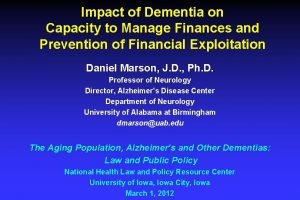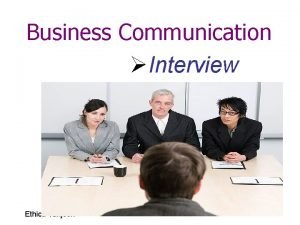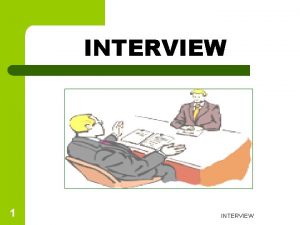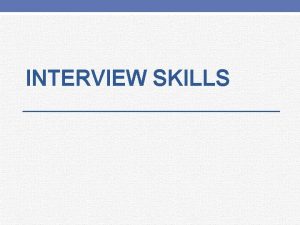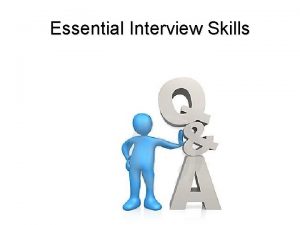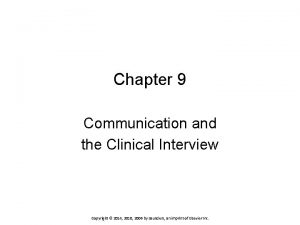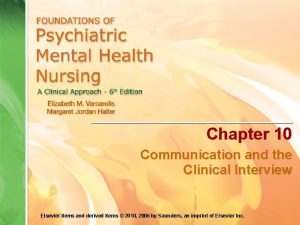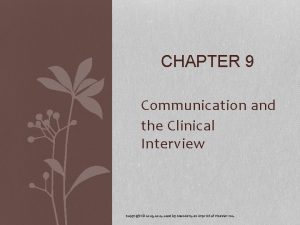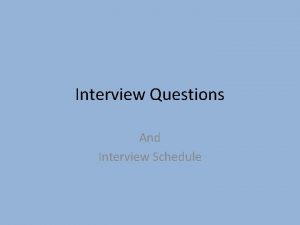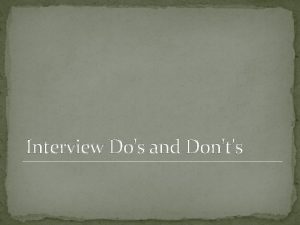CHAPTER 9 Communication and the Clinical Interview 1










































- Slides: 42

CHAPTER 9 Communication and the Clinical Interview 1

The Communication Process • Stimulus—need for information, comfort, or advice • Sender—initiates contact • Message—sent or expressed • Channel—variety of media (hearing, visual, touch, smell) • Receiver—interprets and responds through feedback 2

Therapeutic Communication v Social relationships are different from therapeutic relationships v Therapeutic communication is professional, goal-directed, and scientifically based v v Patient’s feel safer and protected Patient's report being more satisfied with care Increased recovery rates Improved adherence to treatment 3

Therapeutic Communication (continued) It is often during the psychiatric rotation that students discover the utility of therapeutic communication and begin to rely on techniques they once considered artificial. With continued practice, students will develop their own style and rhythm, and eventually these techniques will become a part of the way they communicate with others. 4

Therapeutic Communication (continued) Will saying the wrong thing be harmful to the patient? This is doubtful, especially if the intent is honest, the approach is respectful, and the concern for the patient is genuine. Communication is up to 90% nonverbal, and individuals pay attention to the intent. 5

Case Study You are a new nurse in a psychiatric ward for adolescents. Noah is your first patient. He is depressed and has fresh cuts on his wrist, which is why his mother has had him admitted. While taking his pulse, you see that Noah also has a number of older scars on his arm. When he sees you looking at them, he shakes his head and whispers, “Yeah, well. It’s just gonna keep on happening. ” Copyright © 2018, Elsevier Inc. All rights reserved. 6

Audience Response Question Noah’s whispered statement of “Yeah, well. It’s just gonna keep on happening” does not involve which of the following? A. B. C. D. Channel Stimulus Message Feedback Copyright © 2018, Elsevier Inc. All rights reserved. 7

Case Study • A new nurse on a psychiatric unit wants to effectively communicate in a therapeutic relationship with a patient. • What are some things that will help this communication? 8

Factors That Affect Communication • Personal factors • Environmental factors • Relationship factors 9

Relationship Factors in Communication • Symmetrical relationship: – Equal: Friends or colleagues • Complementary relationship: – Unequal: Difference in status and power, such as between a nurse and patient or between a teacher and student. • Relationship is characterized by inequality (one participant is superior to the other). 10

Verbal Communication • All words a person speaks • Communicates • Beliefs and values • Perceptions and meaning • Can convey • • Interest and understanding Insult and judgment Clear or conflicting messages Honest or distorted feelings 11

Nonverbal Communication • Tone of voice • Emphasis on certain words • Physical appearance • Facial expressions • Body posture • Amount of eye contact • Hand gestures 12

Non-Verbal Communication 13

Interaction of Verbal and Nonverbal Communication • Messages can appear to be one thing when in fact they are another. • People are often less aware of their nonverbal messages and behaviors. • Verbal message can be called the content, while the nonverbal behavior is the process. • Double-bind messages: Mutually contradictory messages, usually given by a person in power. Copyright © 2018, Elsevier Inc. All rights reserved. 14

Discuss Nonverbal Communication (Depicted Below) 15

Case Study As you prepare for the initial interview with 15 -year-old Noah, you learn that he has a history of cutting himself. His parents have separated and are getting a divorce; his father has left and Noah is living with his mother. Noah has been smoking for about a year and a half and his mother suspects that he has come home smelling of marijuana twice now. All three behaviors were ongoing before the father left. Copyright © 2018, Elsevier Inc. All rights reserved. 16

Audience Response Question Which behavior from Noah would be considered a doublebind message? A. He winks at you and says, “Do you date 15 -year-old guys? ” B. He puts his head in his hands, shakes it, and snaps, “I don’t want to do this. Just get me out of here!” C. He sneers at you and almost purrs as he says, “Oh yes. I will tell you anything you want to know. Of course I will. ” D. He cries and shakes, jiggling one leg, as he says softly, “Please. Let’s just not talk about Dad, okay? God, please? ” Copyright © 2018, Elsevier Inc. All rights reserved. 17

Nursing Process: Implementation • Therapeutic communication techniques are specific responses that encourage the expression of feelings and ideas and convey acceptance and respect. • Active listening means using all the senses (hearing, vision, touch, taste and smell) while being attentive to what a patient is saying both verbally and nonverbally. • SOLER (next slide) 18

Active Listening: SOLER • Sit facing the patient at eye level • Observe an open posture • Lean toward the patient • Establish and maintain intermittent eye contact • Relax 19

Therapeutic Communication Techniques • Tools for enhancing communication • Using silence • Active listening • Listening with empathy Table 9 -2 20

Active Listening Principles • The answer is always inside the patient. • Objective truth is never simple. • Everything you hear is modified by the patient’s filters and your own filters. • Feeling confused or uncertain is OK. • Listen to yourself too. Active Listening helps strengthen the patient’s ability to use critical thinking to solve problems. By giving the patient undivided attention, the nurse communicates that the patient is not alone. 21

Asking Questions and Eliciting Patient Responses • Open-ended questions • Closed-ended questions 22

Therapeutic Communication Techniques • • • Accepting Giving recognition Offering self Offering general leads Giving broad openings Placing the events in time and sequence Making observations Encouraging description of perception Encouraging comparison Restating Reflecting Confrontation (Continued. ) 23

Therapeutic Communication Techniques—cont’d • Exploring • Giving information • Seeking clarification • Presenting reality • Voicing doubt • Seeking consensual validation • Verbalizing the implied • Encouraging evaluation • Attempting to translate into feelings • Suggesting collaboration • Summarizing • Encouraging formulation of plan • Focusing 24

Blocks to Therapeutic Communication • Giving premature advice • Minimizing feelings • Being falsely reassuring • Making value judgments • Asking “why” questions • Asking excessive questions • Using clichés • Giving approval—agreeing/cheerleading • Disapproving—disagreeing • Changing the subject 25

Case Study/ Audience Response Question Noah has made it clear he doesn’t want to talk about his dad. But the truth is, as the interview proceeds, he becomes anxious and tries to evade all questions about why he is here. Which type of communication might be most appropriate right now? A. Stop questioning so much and just give him some good advice so he’ll trust you. B. Express honest disapproval of his resistance to help. C. Ask him pointblank why he is evading you. D. Ask a miracle question. Copyright © 2018, Elsevier Inc. All rights reserved. 26

Cultural Considerations: Negotiating barriers • Four areas that may prove problematic for the nurse when interpreting specific verbal and nonverbal messages of the patient include the following: 1. Communication styles 2. Use of eye contact 3. Perception of touch 4. Cultural filters 27

Therapeutic Communication Goals • Feel understood and comfortable. • Identify and explore problems relating to others. • Discover healthy ways of meeting emotional needs. • Experience satisfying interpersonal relationships. 28

Therapeutic Communication Goals • Feel understood and comfortable. • Identify and explore problems relating to others. • Discover healthy ways of meeting emotional needs. • Experience satisfying interpersonal relationships. 29

Preparing for the Interview • Pace • Setting • Seating • Introductions • Initiating the interview 30

Attending Behaviors Attending behaviors encourage talking. • Maintain eye contact. • Control vocal qualities (tone and speech rate). • Face the person. • Use encouraging gestures. • Track verbal content; do not change the subject. • Use open-ended vs. closed-ended questions. • Asking why? may place a person on the defensive and cause discomfort. 31

Helpful Guidelines • Speak briefly • When you do not know what to say, say nothing • When in doubt focus on feelings • Avoid giving advice • Do not rely on asking questions • Pay attention to nonverbal clues • Focus on the patient 32

Tactics to Avoid • • Arguing, minimizing, or challenging the patient Giving false reassurance Interpreting or speculating Probing into sensitive areas the patient doesn’t want to discuss Trying to “sell” the patient on accepting treatment Joining in attacks patients launch on others Participation in criticizing other staff members Copyright © 2018, Elsevier Inc. All rights reserved. 33

Clinical Supervision • Communication and interviewing are acquired skills • Fosters professional growth and helps minimize the development of nontherapeutic nurse-patient relationships. 34

Process Recording • Written record of a segment of the nurse-patient session that reflects as closely as possible the verbal and nonverbal behaviors of both patient and nurse • Useful tool for identifying communication patterns 35

Bathe Technique • Background: What is going on in your life? • Affect: How do you feel about what is going on? • Trouble: What troubles you the most about this problem? • Isolation of the key issues • Handing: How have you been handling (coping) with this problem? • Empathy: This must be very difficult for you. 36

NURS • Name the patient’s emotion (It seems as though the constant headaches really get you frustrated. ) • Understand (I can see why you feel this way. ) • Respect (You’ve been through a lot and that takes courage. ) • Support (I want to help you get better. ) 37

Information Communication Technologies • Definition: Use of electronic information and telecommunication technologies to support long-distance clinical health care • Uses: Live interactive mechanism, as a way to track clinical data and to provide access to people who otherwise might not receive good medical or psychosocial help. Copyright © 2018, Elsevier Inc. All rights reserved. 38

Information Communication Technologies (Cont. ) • Mobile Applications • • • Monitor, diagnose, treat, and communicate with patients Mobile phones are used at a high rate Many quickly adoptable apps available More research is needed SAMHSA Resources for suicide prevention, bullying prevention, and underage drinking prevention Copyright © 2018, Elsevier Inc. All rights reserved. 39

Telehealth Technologies • Intel™ developed a mobile phone application that mirrors cognitive behavioral therapy (CBT). • Touchscreen “Mood Map” for Android and i. Phone invites users to plot mood during the day and view trends. • The University of Colorado Hospital is using Skype to work with children with autism and their families. • Lacks reimbursement by third-party payers. 40

Audience Response Question As a nurse assesses a new client, the nurse makes sure the door remains open. Which type of communication factor is this action? A. Environmental B. Relationship C. Personal D. Mutual safety 41

Audience Response Questions A nurse assesses a newly hospitalized client. Which communication technique will the nurse use most? A. Rapid, high-pitch voice tone B. Closed-ended questions C. Direct eye contact D. Frequent touch 42
 Scifc
Scifc Interview skills in business communication
Interview skills in business communication Hình ảnh bộ gõ cơ thể búng tay
Hình ảnh bộ gõ cơ thể búng tay Frameset trong html5
Frameset trong html5 Bổ thể
Bổ thể Tỉ lệ cơ thể trẻ em
Tỉ lệ cơ thể trẻ em Gấu đi như thế nào
Gấu đi như thế nào Chụp tư thế worms-breton
Chụp tư thế worms-breton Chúa yêu trần thế
Chúa yêu trần thế Các môn thể thao bắt đầu bằng tiếng nhảy
Các môn thể thao bắt đầu bằng tiếng nhảy Thế nào là hệ số cao nhất
Thế nào là hệ số cao nhất Các châu lục và đại dương trên thế giới
Các châu lục và đại dương trên thế giới Cong thức tính động năng
Cong thức tính động năng Trời xanh đây là của chúng ta thể thơ
Trời xanh đây là của chúng ta thể thơ Mật thư tọa độ 5x5
Mật thư tọa độ 5x5 Làm thế nào để 102-1=99
Làm thế nào để 102-1=99 Phản ứng thế ankan
Phản ứng thế ankan Các châu lục và đại dương trên thế giới
Các châu lục và đại dương trên thế giới Thể thơ truyền thống
Thể thơ truyền thống Quá trình desamine hóa có thể tạo ra
Quá trình desamine hóa có thể tạo ra Một số thể thơ truyền thống
Một số thể thơ truyền thống Bàn tay mà dây bẩn
Bàn tay mà dây bẩn Vẽ hình chiếu vuông góc của vật thể sau
Vẽ hình chiếu vuông góc của vật thể sau Thế nào là sự mỏi cơ
Thế nào là sự mỏi cơ đặc điểm cơ thể của người tối cổ
đặc điểm cơ thể của người tối cổ Thứ tự các dấu thăng giáng ở hóa biểu
Thứ tự các dấu thăng giáng ở hóa biểu Vẽ hình chiếu đứng bằng cạnh của vật thể
Vẽ hình chiếu đứng bằng cạnh của vật thể Fecboak
Fecboak Thẻ vin
Thẻ vin đại từ thay thế
đại từ thay thế điện thế nghỉ
điện thế nghỉ Tư thế ngồi viết
Tư thế ngồi viết Diễn thế sinh thái là
Diễn thế sinh thái là Dot
Dot Số nguyên là gì
Số nguyên là gì Tư thế ngồi viết
Tư thế ngồi viết Lời thề hippocrates
Lời thề hippocrates Thiếu nhi thế giới liên hoan
Thiếu nhi thế giới liên hoan ưu thế lai là gì
ưu thế lai là gì Sự nuôi và dạy con của hươu
Sự nuôi và dạy con của hươu Khi nào hổ con có thể sống độc lập
Khi nào hổ con có thể sống độc lập Sơ đồ cơ thể người
Sơ đồ cơ thể người Từ ngữ thể hiện lòng nhân hậu
Từ ngữ thể hiện lòng nhân hậu
